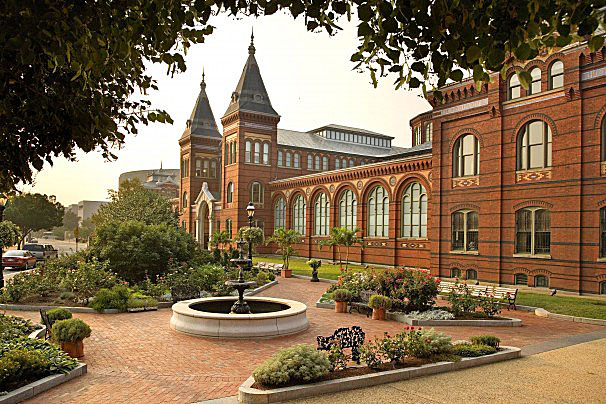An innovation in renovation

The Arts and Industries Building as seen from the East Door of the Smithsonian Institution Building, the “Castle.” (Photo by Eric Long)
During the 1800s, architect Adolf Cluss’s buildings were a hallmark of the Washington, D.C., cityscape. His visionary designs incorporated natural light and circulation, high ceilings and fireproof materials that foreshadowed modern construction practices. Although many of Cluss’s buildings no longer stand, his masterpiece is still here at the Smithsonian, a structure that encapsulates the most revolutionary aspects of his architecture—the Arts and Industries Building. Stephen Callcott of the Historic Preservation Office in Washington, D.C., called the A&I Building “one of Washington’s great architectural monuments of the late 19th century, expressing the era’s interest in technological innovation.” Because of the historical significance of the building and its relevance to modern progress, reopening and restoring A&I has been one of my top priorities. Innovation thrives throughout the Smithsonian and what better way to reinvigorate the spirit of Cluss’s signature building than by turning it into a shrine to innovation in our century?
When the A&I Building opened in 1881, known then as the U.S. National Museum, it was just in time to host President James Garfield’s inaugural ball. In the center of the rotunda stood the grand Statue of America, created by sculptor Caspar Buberl, its hand holding aloft an electric light to represent “the skill, genius, progress, and civilization of the 19th century.” A&I was one of the first buildings in the District to feature electric lights, before even the Capitol Building. Through its long history, the A&I Building continued to put innovation in the limelight, celebrating new technologies such as photography, aviation and telegraphy. Even space flight was represented as rockets stood sentinel along the length of A&I’s exterior for a time before the National Air and Space Museum was created. Eventually, interior walls were added to the grand rotunda to accommodate exhibitions and offices, dividing up the space in A&I and blocking ambient lighting. Over time, the building lost its functionality and its original aesthetic. In 2004, the decision was made to close the A&I Building until a new plan could be developed for its use. When I came to the Smithsonian in 2008, the Board of Regents agreed with my recommendation that we work to restore the A&I Building’s historic authenticity and reopen it. I could not be more pleased that the time is rapidly approaching for the building to take its rightful place among the Smithsonian family. In late summer 2014, the long wait will be over.
The first step in the renovation of A&I was to make the building structurally sound by installing a new roof, steel supports and windows. That phase of the work will be completed this fall. But as we considered our own long-term plans for the building, we learned firsthand that necessity truly is the mother of invention. A presidential commission included the A&I Building as a potential site in its proposal for a National Museum of the American Latino. A bill now pending in Congress would make the new museum a reality at A&I. We know from our experience with the National Museum of the American Indian and the National Museum of African American History and Culture that it takes at least seven years to bring a museum to life. We do not want the building to stand idle for that long if it is, indeed, to become the site of the new museum, so we needed an interim plan that would allow A&I to make a smooth transition to its long-term mission.
That meant that every exhibit, every program, every event in the renovated A&I Building needed to be active, flexible and portable. We had to think about A&I as a space in transition more than a permanent structure. This has given us the opportunity to look at every aspect of the building through the lens of innovation, including the exhibitions we choose, the programming we develop, and the competitions, contests, and intellectual challenges we create to inspire imagination. We are even being innovative in the entrepreneurial way we are raising funds for the project—creating a new model for the Smithsonian that is more like a start-up business with its creative approaches to planning and development. By identifying new external and internal funding sources, including restaurants that continue visitors’ learning experiences and dynamic partnerships with other innovation leaders, A&I will allow us to apply its lessons to the entire Smithsonian— crucial in these fiscally challenging times.

Three U.S. military rockets stand on display before the Smithsonian Institution’s Arts & Industries Building in what would become known as “Rocket Row”, early 1960s. (Photo courtesy of Smithsonian Institution Archives)
For the A&I plan to work, we needed to find many willing partners with compatible interests that would help seed the development of the building. The first to step up to the plate was the U.S. Patent and Trademark Office, which is helping to create within A&I an “Innovation Pavilion” that will reveal how patents and the intellectual property system drive innovation. Talks are ongoing with other institutions, corporations and non-profits that bring their own perspectives to American innovation. We will draw on their expertise and our own as we develop programming that will excite learning about innovation in art, history, science and culture. We want visitors to the Smithsonian to learn about the impact ingenuity plays in all of our lives. We want to inspire a new generation of innovative thinkers, creators and inventors. Now, with a central hub for innovation at the A&I Building, more and more of these stories, programs, and exhibitions can make innovation real.
Just as creative thinking can’t be constrained by convention, innovation at the Smithsonian is not confined to the A&I Building, however. Spacecraft that allowed us to go to the moon and beyond can be found at the National Air and Space Museum. Boundary-breaking artists populate the Smithsonian American Art Museum, the Hirshhorn Museum and Sculpture Garden, the National Portrait Gallery, the Arthur M. Sackler Gallery and Freer Gallery of Art, and the National Museum of African Art. Cultural innovations abound at the National Museum of the American Indian, the Smithsonian Latino Center, and the Smithsonian Asian Pacific American Center and will soon proliferate at the National Museum of African American History and Culture when it opens in 2015. The National Museum of American History’s Lemelson Center for the Study of Invention and Innovation has long recognized pivotal creations and those who realized their dreams. When the Lemelson Center reopens upon the completion of the museum’s new west wing in 2015, its exhibition Places of Invention will highlight nationwide hotbeds of creativity and innovation. Also part of the NMAH’s renovation, American Enterprise, a partially crowd-sourced exhibition, will focus on innovation in agriculture, consumer finance, communications, manufacturing and the service industry in the United States. A complementary website features blog posts from people who were affected by those developments.

Columbia takes flight to rejoin her sisters atop the Arts & Industries Building. (Photo by Mark Avino)
Innovative technology underpins the Smithsonian’s initiatives: digital badging, such as that done by Cooper-Hewitt, National Design Museum and the Smithsonian Center for Learning and Digital Access allow the credentialing and recognition of educational tasks; 3D scanning of our objects invites researchers and students to explore some of our most treasured items in great depth; the crowdsourcing of the American Enterprise exhibition and crowdfunding of the Sackler Gallery exhibition, Yoga: The Art of Transformation, unleashes the power of our visitors through technology; and interactive learning tools augment people’s physical visits to our museums. Digital technology is as transformative today, not only for the Smithsonian, but also for our visitors’ experience, as were the electric lights in the newly built A&I Building more than a century ago.
Ever since it opened to the public, a special Caspar Buberl sculpture has stood above the A & I Building’s main entrance. Columbia Protecting Science and Industry features three graceful female figures, two representing science and industry. A third, Columbia, watches over them, symbolizing the nation’s responsibility to shepherd and cultivate technological progress. Recently, the sculpture was returned to its rightful location atop the building after traveling for repair and restoration. Its reinstallation is a fitting celebration of the Arts and Industries Building nearing the end of its long hiatus. Looking down from their aerie, the three graces await the day when their building once again is a source of inspiration and learning for millions of visitors to the Smithsonian, reminding everyone that at the core of the American experience lies the beating heart of innovation.
Editor’s Note: The Arts & Industries Building itself has inspired innovation and creativity in unexpected ways. Artist Matthew Scheuerman has an interesting perspective. He created this evocative matte painting, “The Lodge,” after visiting Washington, D.C., in 2006. “I took some photos of some of the various famous sites around the National Mall,” he writes. “One of my favorite buildings was the Smithsonian Arts and Industries building. I had something ‘Harry Potteresque’ in mind, but after sketching out quite a few ideas, I decided to just let some of my personal interests and style come out.”
Posted: 5 June 2013
- Categories:









